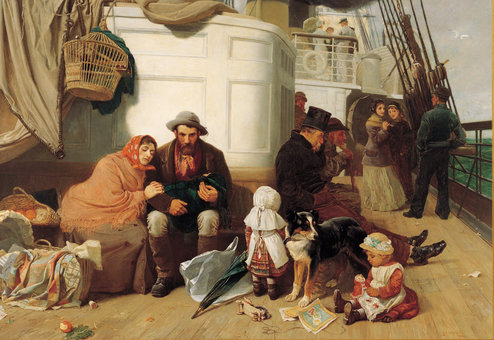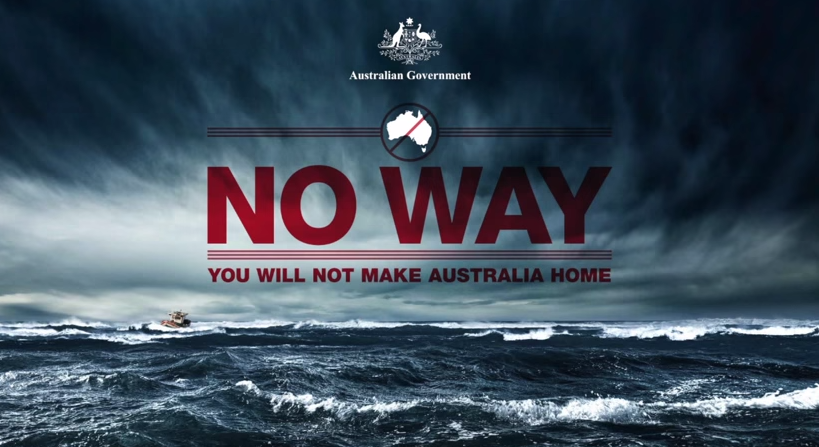Barry York resides and works in Canberra, Australia. He is a former Research Officer with the Australian Parliamentary Library, where he was on the immigration and refugee desk. Below is York’s blog post A case for an amnesty for asylum seekers in Australia, republished with his permission, along with some commentary and additional links. The post was originally published on C21st Left, York’s blog.
Amnesties occur when a government grants a pardon to a group of individuals. It can apply to prisoners, or people in other forms of detention. Or even people not in prison or detention. An amnesty for asylum seekers would be a pathway to permanent residence.
Some historical background
Australia’s experience of amnesties in the immigration field date back to Australia Day (26 January) 1976 when Prime Minister Malcolm Fraser granted amnesty to illegal immigrants. At that time, this meant individuals who had entered Australia lawfully but overstayed their visas. The period in which applications could be made for amnesty expired on 30 April that year. It was an offer too good to refuse.
The Coalition government realized that these ‘illegals’ were in the country anyway. They were part of Australian society, despite their official status, and working or bludging, or having fun, playing music, fishing, reading, chatting with neighbours, going to the pub, etc, like the rest of us. And, again like the rest of us, they had a future here. Fraser’s standing in immigration history is being rewritten and mythologized by all-too-eager academics who seem to have put aside any semblance of critical approach.
Fraser was responsible for formalising the distinction between genuine and non-genuine refugees through the establishment of the Determination of Refugee Status Committee in 1978; a decision that laid the basis for all the subsequent problems arising from exclusion.
When it came to the ‘Australia Day’ amnesty of 1976, Fraser gave with one hand while taking with the other. He also funded a special unit to hunt them down. A cost-benefit analysis may have found that the benefits outweighed the costs in letting them stay. Not that that is the only – or main – point. But what is important to note is that the amnesty did not alter the basic policy: over-stayers after 30 April 1976 were in big trouble if caught.
Australia’s next experience of amnesty occurred during the Hawke years when, in 1989, Prime Minister Bob Hawke announced that the thousands of Chinese students studying in Australia would be permitted to remain here until 31 July 1990 on a temporary basis. This was later extended to June 1994 and then, as was the intention all along, 42,000 were allowed to apply for permanent residence. Again, it was an offer too good to refuse. Who in their right mind, after the Tiananmen massacre, would want to return to live under a social-fascist regime compared to life in bourgeois-democratic Australia?
The situation today: about 30,000 in limbo and detention
Currently, in Australia, living as part of our community and society but separated from it by various restrictions imposed by a ‘bridging visa’ system, there are more than 27,000 people, mostly asylum seekers waiting to have their cases determined. Most have been waiting for a long time. There are also 2,500 in detention centres.
It’s always helpful to look on the bright side in any bad situation. There are about ten thousand fewer in detention today than there were under Gillard’s Labor government. When it comes to detention of asylum seekers, Labor holds the record. (Lest we forget).
It is curious, to me, that pro-refugee groups tend to advocate the more rapid processing of these asylum seekers’ claims, as though it is fair enough to identify those who are not genuine refugees, rather than questioning the system itself. Sadly, this is the main paradigm in public discourse. Nearly everyone, the Greens included, think it’s fair enough to keep out asylum seekers who are not genuine refugees. So, a family might sell everything in, say, Iran, risk their lives by escaping, lose nearly everything to unscrupulous people-smugglers (note: these guys are not to be romanticized) and then having made it across the dangerous, often deadly, waters, under the old ‘Fraser system’ they could be be rejected because they are found to be ‘economic’ refugees not the ‘political’ type. Needless to say, within this paradigm, they have to leave the country, which they will not do voluntarily. They therefore (the dominant thinking goes) need to be detained in some way, lest they abscond into the community. The Greens want this process to be accomplished quickly, more efficiently and ‘nicely’; Labor and the Coalition are rather less polite about it, though at each election since 1996, Shadow Ministers for Immigration have promised to ‘speed up’ the determination process.
Those who were denied permanent residency because they were found to be economic refugees made the journey in order to have a better life – and, after such a journey you can be sure that means they will want to improve things generally. My parents paid ten pound each to get here in 1954, and were allowed in. Their motivation was a better life for themselves but mostly for my future. Both my parents made special contributions to their community (in Brunswick, Melbourne) and in other ways. Had they not been ‘authorised’ migrants but rather ‘economic refugees’, and allowed in, their contributions would have not been diminished in any way.
There are financial and human costs involved in maintaining these 30,000 people in their current state. Most of the costs are borne by government – you and me. We are denying each of them the opportunity to be productive and useful members of society, as a result of restrictions placed on them through the bridging visas. As I say to my wife: That asylum seeker lighting a fire and jumping up and down on top of the detention centre’s roof may be our next dentist! So, in addition to the cost of keeping 2,500 people in detention, and in addition to the cost of ensuring the other 27,000 don’t abscond, why not advocate something that makes much more sense than wanting nicer, more efficient, ways of keeping people out? Why not allow them the opportunity to contribute to the community and society without the restrictions of the bridging visas by letting them in?
In other words: let’s call for an amnesty for them all.
Given the current parliamentary political situation in Australia, the demand could reap some benefits. After all, isn’t the ALP keen to recapture votes it has lost to the Greens on this issue? Aren’t the Greens out to convince us that they represent a humanitarian alternative on the refugee issue? Wouldn’t Labor and the Greens have the numbers in this fine humanitarian and entirely practicable act? And 30,000 is not a big number. For heaven’s sake, 30,000 is about a third of the net loss Australia experienced through permanent departures last year. And last year we took in 200,000 newcomers.
Above all, from the viewpoint of the prevailing consensus, the actual refugee policy would not have to change. Much as I think it should, and must – and will (one day). An amnesty can be granted as an act of compassion, without any need to change current refugee policy.
‘Christian compassion’ for Australia Day next year.
Let’s call it… er… well… “Christian compassion”. Yes, Christian compassion for ‘Australia Day’ 2016. Marking the 40th anniversary of the first amnesty granted by a Coalition government in Australia.
Tony: ya there?
Related reading
Some related reading suggested by the author:
- Australia and Refugees, 19012002: An Annotated Chronology Based on Official Sources
- Asylum seekers and refugees: what are the facts?
- Boat arrivals in Australia: a quick guide to the statistics
- The Detention of Boat People
The remainder of the related reading section has been added by the Open Borders: The Case editorial team and has not been vetted by York, the author of the original post.
On migration to Australia:
- What does the future hold for asylees in Australia? by Michelangelo Landgrave, Open Borders: The Case, April 24, 2014.
On refugees:
- Junk the international refugee system, and open the borders by John Lee, Open Borders: The Case, October 22, 2014.
- Literally refusing to rescue drowning people: your taxpayer funds at work, putting immigrants to death by John Lee, Open Borders: The Case, January 9, 2015.
- A Survey of the United States Humanitarian Migrant Statuses by Michelangelo Landgrave, Open Borders: The Case, May 14, 2014.
- Or see all our blog posts tagged refugees.
On moderate immigration reform groups and the differences with those who support radical migration liberalization:
- Are immigrant rights activists friends of open borders? by Vipul Naik, Open Borders: The Case, October 25, 2012.
- How do open borders meaningfully differ from mainstream “immigration reform”? by John Lee, Open Borders: The Case, February 28, 2014.
And another miscellaneous article: An Apology, Not a Fine by Joel Newman, Open Borders: The Case, February 24, 2013.
The painting featured at the top of this post is “The Immigrants’ Ship,” by John C. Dollman, and is on display at the Art Gallery of South Australia.



![t1larg.sfax.boat.gi.afp[1]](http://openborders.info/wp-content/uploads/2015/01/t1larg.sfax_.boat_.gi_.afp1_.jpg)


